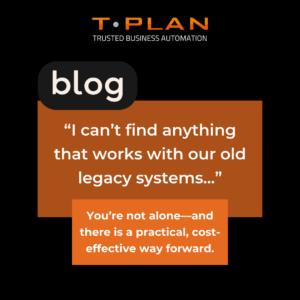Robotic Process Automation (RPA) has become a cornerstone of digital transformation, empowering businesses to automate repetitive tasks, enhance accuracy and streamline operations. However, the success of RPA hinges on one critical factor – thorough testing.
Effective RPA testing validates that automated workflows perform reliably under real-world conditions, reducing errors, enhancing compliance, and delivering measurable improvements to your business outcomes. Test automation plays a critical role in ensuring these workflows function correctly. Additionally, incorporating machine learning and intelligence into RPA systems can further enhance their capabilities, offering your business highly advanced insights and automation.
This guide offers a comprehensive, step-by-step approach to RPA testing, covering tools, processes and best practices to help you achieve robust and scalable automation. Additionally, we’ll highlight how T-Plan’s advanced automation platform specifically its RPA tools simplifies every step of the testing process, empowering organisations to reduce manual effort and improve test management.

Table of Contents
What is RPA testing?
Robotic Process Automation (RPA) testing ensures that bots function as intended, accurately mimicking human interactions across applications, systems and interfaces. Unlike traditional software testing, RPA testing focuses on validating complex workflows that span multiple systems and depend on dynamic environments.
RPA testing is critical because small errors in automation can escalate into significant disruptions. Beyond individual tasks, testing ensures that data flows seamlessly across systems and that bots respond appropriately to unexpected inputs or failures. Intelligence plays a key role in RPA workflows, allowing for more intelligent decision-making and improved accuracy.
Testing tools play a significant part in ensuring these processes are effective and reliable, particularly when managing large-scale automation projects.
Key Objectives of RPA Testing
- Workflow Validation: This ensures that bots correctly execute tasks based on defined business rules.
- Error Prevention: Identifies potential issues before deployment, reducing risks of production failures.
- Scalability Assurance: Confirms that bots can handle increased workload volumes or integrate with additional systems over time.
Key Challenges in RPA Testing
While RPA testing is essential, it comes with unique challenges due to the dynamic nature of RPA systems and the diversity of environments in which bots operate.
1. Complexity:
Bots often interact with multiple systems, including legacy applications, APIs and databases. These dependencies make testing intricate and require a robust framework for interconnected workflows.
For example, testing a bot that processes invoices may involve validating interactions with ERP systems, email notifications and file uploads.
2. Scalability:
RPA implementations typically start with a small set of tasks and grow over time. Testing must ensure that bots continue to function as the scope and volume of automation increase.
Scenarios such as processing 1,000 vs. 10,000 transactions may expose performance bottlenecks.
3. Dynamic Environments:
Interfaces and systems often change, especially in environments leveraging cloud services, necessitating thorough testing to avoid disruptions. This can result in bots “breaking” if testing is not thorough.
T-Plan’s Relevance
T-Plan’s platform ensures bots are tested comprehensively across workflows, systems and integrations using advanced automation testing tools. Its end-to-end validation capabilities allow teams to identify issues in even the most complex environments, providing consistent results and reducing risks.
Types of RPA tests
As RPA systems operate within complex workflows, testing ensures they function as expected under various conditions. To achieve this, different types of RPA tests are conducted, each targeting specific aspects of automation performance and reliability.
Functional testing ensures that bots perform tasks according to predefined business rules and expected outcomes. It validates whether the automation is functioning as designed and delivers the correct results. Its focus is on end-to-end workflows, data accuracy and proper execution of tasks.
Example: Testing a bot that processes employee leave requests to ensure that it accurately calculates leave balances and updates HR records without errors.
Regression testing ensures that any updates to bots, workflows or underlying systems do not disrupt existing functionality. By automating regression testing, you can efficiently validate repeated scenarios and identify issues caused by new changes. Its focus is on ensuring updates or enhancements do not “break” previously functioning workflows.
Example: After adding a new validation step to an invoice-processing bot, regression testing ensures that the previous steps (data extraction and entry into an ERP system) still function correctly.
Performance testing measures how bots handle varying workloads, high transaction volumes and processing speed under stress. This is critical for determining whether bots can operate efficiently in a production environment. Performance testing focuses on stability, responsiveness and resource usage under different loads.
Example: Evaluating how a bot handles 5,000 transactions per hour compared to 500, ensuring there are no delays or failures at peak loads.
Security testing ensures that bots operate securely, protecting sensitive data and adhering to regulatory standards. It involves identifying vulnerabilities and ensuring that bots comply with data protection and access control measures. The main focus is on data security, unauthorised access prevention and regulatory compliance.
Example: Testing a bot that handles customer credit card information to ensure data is encrypted during processing and that access is restricted to authorised users only.
How T-Plan supports all RPA test types
With support for functional, regression, performance and security testing, T-Plan offers an all-in-one solution that simplifies testing processes and provides detailed insights into automation performance.
Setting up an effective RPA test environment
When setting up your RPA test environment it is important that it is well-constructed so that you can perform reliable and accurate RPA testing. The test environment must closely replicate the production environment to detect and address issues before deployment.
Key components of an effective RPA test environment
System integration:
The test environment should include all systems, applications and tools that the bots will interact with in production. This includes:
- Legacy systems.
- APIs and third-party integrations.
- External databases and software applications.
Realistic test data:
Using realistic data ensures that bots are tested against the kinds of scenarios they’ll encounter in production. Consider the following when preparing test data:
- Include edge cases, exceptions and invalid inputs.
- Prepare data that matches actual business use cases, such as different file formats or data structures.
- Ensure compliance with data privacy regulations, such as anonymising sensitive customer or employee information.
Mirroring production conditions:
- Replicate user roles, access levels and permissions that the bots will use in production.
- Simulate network conditions, server loads and other environmental factors to ensure the bots can handle real-world challenges.
Common mistakes to avoid
- Underestimating complexity: Not including all critical systems or workflows in the test environment can result in undetected failures.
- Inadequate test data: Using synthetic or incomplete data may overlook potential issues, especially when processing edge cases.
- Neglecting scalability: A test environment that doesn’t replicate production scale may lead to poor performance when workloads increase.
How T-Plan simplifies test environment setup
T-Plan’s platform is designed to make test environment creation and management as seamless as possible. Key benefits include:
- Reusable environments: Set up once and reuse for different tests, saving time and effort.
- Real-world accuracy: Simulate production-like conditions with configurable system and data parameters.
- Scalability testing: Easily test bots under high-load scenarios to ensure performance under peak conditions.
By mirroring production conditions, T-Plan enables you to identify and address potential issues before they impact your operations.
Test planning and strategy
A well-defined test plan and strategy are the foundation of effective RPA testing. Without a clear roadmap, testing efforts can become inefficient, resulting in missed bugs, wasted time and increased costs. A testing strategy can help organisations in any industry prioritise workflows, define objectives, and select the right approaches to achieve comprehensive coverage.
Defining objectives and scope
Before executing tests, it’s essential to outline what you aim to achieve and which areas to prioritise:
Identify critical workflows:
- Focus on high-risk processes that have the greatest business impact, such as financial reconciliations or customer-facing operations.
- Prioritise workflows that are prone to errors, involve sensitive data or require significant manual intervention.
Set measurable objectives:
- Ensure bots meet functional requirements, such as processing invoices with 100% accuracy.
- Define performance goals, such as completing tasks within a specific time frame.
- Confirm compliance with regulatory standards.
Determine scope:
- Identify which bots, workflows and integrations will be tested.
- Decide whether tests will cover end-to-end workflows or focus on specific components.
Developing a comprehensive test strategy
A successful test strategy integrates both manual and automated testing approaches to ensure full validation.
- Balance manual and automated testing: Use automated testing for repetitive, rule-based scenarios to save time and ensure consistency. Manual testing should complement this by focusing on edge cases, exploratory testing and scenarios requiring human judgment.
- Plan for iterative testing: Testing should be an ongoing process, not a one-time event. Begin testing early in the development lifecycle to catch and resolve defects before they escalate. Continuous integration and testing validate incremental changes, ensuring workflows remain stable as they evolve.
- Include regression and performance testing: Regression testing verifies that updates or modifications do not disrupt existing workflows, while performance testing ensures bots remain responsive and efficient under various workloads.
How T-Plan supports test planning
T-Plan’s platform simplifies test planning by providing integrated tools that streamline the entire testing lifecycle:
- Centralised planning: Define objectives, scope and test strategies within a single interface, ensuring all teams stay aligned.
- Real-time tracking: Monitor the progress of test execution, identify bottlenecks and adjust strategies on the fly.
- Customisable templates: Use pre-built templates for common RPA scenarios, making test planning faster and more efficient.
With T-Plan, teams can organise, execute, and monitor their testing strategies with confidence, ensuring nothing is overlooked.
Writing effective RPA test cases
Next, it’s important to remember that RPA test cases are the foundation of a successful testing strategy. They guide the validation process and ensure that workflows are thoroughly and consistently tested. Writing clear, well-structured test cases is essential to uncover potential issues, especially in complex or high-stakes automation scenarios.
Test case structure
Each test case should be designed to ensure accuracy and repeatability. A standard test case includes the following components:
- Preconditions: Define the initial state of the system or environment before the test begins.
- Input data: Specify the data or variables the bot will process during the test.
- Expected outcomes: Clearly outline the results the bot should produce if the process functions correctly.
- Steps: Provide detailed instructions for executing the test, ensuring any tester can follow them easily.
Real-world scenarios
Your test cases must reflect real-world conditions to ensure bots behave reliably in production. To achieve this:
- Simulate actual business processes: Use data and workflows that represent day-to-day operations, including standard inputs and outputs.
- Include edge cases and exceptions: Test how bots handle invalid data, unexpected inputs or unusual scenarios, such as incomplete forms or system outages.
- Address abnormal inputs: Verify that bots can process unexpected values, like negative numbers or unusually formatted dates, without errors.
How T-Plan simplifies test case creation
T-Plan’s GUI-based interface empowers testers to design, manage and execute test cases without extensive coding knowledge. This user-friendly approach accelerates test creation, enabling teams to focus on identifying and resolving issues in complex workflows.
Best practices for RPA testing
Implementing best practices for RPA testing ensures the efficiency and effectiveness of your testing processes. By adopting proven methods, you can identify issues early, streamline test execution and deliver reliable automation solutions.
Start testing early in development
Begin testing at the earliest stages of RPA development to detect and resolve defects before they escalate. Early testing allows you to address issues during the design and build phases, reducing the risk of costly errors in production. Incorporate testing into each development milestone to maintain quality as the system evolves.
Use continuous testing
Continuous testing ensures that bots are validated throughout their lifecycle. This approach supports incremental updates, such as workflow modifications or integration changes, by validating them in real-time. Continuous testing helps teams maintain system stability and adaptability while minimising downtime.
Leverage automation
Use automated testing for repetitive, rule-based scenarios to save time and improve consistency. Automated regression tests, for example, are invaluable for verifying that updates don’t disrupt existing workflows. At the same time, combine automation with manual testing to ensure edge cases and complex scenarios are adequately covered.
How T-Plan integrates best practices
T-Plan’s automation tools seamlessly support these best practices. With capabilities for early testing, continuous integration and automated regression testing, T-Plan enables organisations to detect defects early, streamline their testing processes and maintain system reliability. By integrating automation and manual testing into a unified workflow, T-Plan ensures comprehensive coverage and maximised efficiency.
Challenges in RPA testing and how to overcome them
Although it has great benefits RPA testing still comes with its unique set of challenges due to the complexity and dynamic nature of automated workflows. Identifying these challenges and implementing solutions is essential to ensure the reliability and efficiency of your bots. Some common challenges include:
Flaky workflows
RPA workflows often rely on dynamic elements, such as frequently changing user interfaces or variable system responses. These dependencies can lead to inconsistent test results or bot failures.
To stabilise workflows, use stable test environments that mirror production conditions as closely as possible. Employ reusable test scripts and configurations to manage dynamic elements effectively. Tools that can handle UI changes, like T-Plan, are particularly valuable for managing flaky workflows.
Dynamic environments
Bots operate across multiple systems, many of which are updated or modified regularly. These changes can disrupt existing automation, requiring frequent adjustments to bots and tests.
The solution? Leverage robust test management tools. Adopt platforms that simplify test creation, execution and monitoring. With T-Plan, teams can efficiently manage dynamic environments by automating updates to test cases when system changes occur.
Testing scalability
Ensuring that bots perform reliably as the scale of operations grows can be difficult. High transaction volumes or increased bot utilisation may expose weaknesses that aren’t apparent in smaller-scale testing.
Be sure to include performance testing in your strategy to evaluate bots under heavy workloads. T-Plan’s tools can simulate high transaction volumes, ensuring bots remain reliable and responsive during peak demand.
Monitoring and continuous testing for RPA
RPA systems are not static; they evolve with changing business requirements, technology updates and integrations. Monitoring and continuous testing are critical to ensuring that bots remain reliable, efficient and compliant long after deployment.
Continuous testing ensures that bots consistently meet performance, accuracy and compliance standards. By actively validating bots as workflows and systems change, organisations can detect and resolve issues before they escalate, maintain operational stability during updates or environmental changes and avoid disruptions in critical business processes.
For example, a bot processing customer orders must be continuously tested to ensure it adapts seamlessly to changes in order forms, inventory systems or API endpoints.
Some strategies for continuous testing include:
- Automate regression testing:
Automating regression tests allows teams to validate updates without re-running tests manually. This ensures that modifications to bots or environments don’t disrupt existing workflows.
- Leverage analytics and monitoring tools:
Monitoring tools provide real-time insights into bot performance, helping teams identify bottlenecks, anomalies or inefficiencies. These insights can guide proactive adjustments to maintain optimal performance.
- Plan for regular reviews and updates:
Establish a schedule for reviewing and updating test cases to reflect changes in workflows or business requirements. Keeping test cases current ensures that bots remain aligned with organisational goals.
How T-Plan supports monitoring and continuous testing
T-Plan’s platform offers powerful features for ongoing RPA validation. Automated regression testing simplifies the process of verifying updates, ensuring workflows remain stable. Integrated monitoring tools track bot performance in real-time, providing actionable insights to maintain efficiency and reliability. With T-Plan, organisations can confidently manage their RPA systems in dynamic and evolving environments.
Final thoughts: building confidence in RPA systems
RPA testing is essential for delivering reliable, scalable and efficient automation. By incorporating early testing, continuous validation and robust planning, businesses can minimise risks and ensure their bots perform flawlessly in real-world conditions. Collaboration between teams and investing in the right tools are critical to achieving these goals.
With T-Plan’s powerful testing platform, you can streamline RPA testing, reduce manual effort and ensure long-term success. From creating reusable test cases to automating regression and monitoring performance, T-Plan empowers you to build confidence in your automation solutions.
Take the next step towards robust RPA testing. Visit T-Plan to explore our platform, request a demo or start a free trial today.


